Akebia - growing and caring for exotic liana
Akebia is a perennial dicotyledonous plant of the Lardizabalov family, which is distinguished by its beautiful purple or brown flowers and useful properties. Akebia is considered an unpretentious plant, so growing and caring for it is within the power of even a novice gardener.
Content:
- Description of akebia
- Growing conditions
- Reproduction of vines
- Planting and transplanting
- Akebia care
- Using akebia
- Diseases and pests
Description of akebia
Akebia (chocolate liana) is a perennial liana-like shrub, reaching a height of 7 meters. Usually she weaves on any support that comes her way. But if there is nothing suitable nearby, it spreads, forming a thick carpet of leaves and flowers.
The homeland of akebia is East Asia, Japan. Grows well on the southern coast of Crimea, in the Caucasus. In our conditions, akebia is grown as a houseplant. Lovers of exotic plants can experiment by growing a liana in the garden, even in the middle lane.
Features of the plant:
- Akebia leaves are evergreen. But they remain so only in warm climates. In our latitudes, they fall with the onset of cold weather. The leaf consists of 5 lobes, each of which has the shape of an egg with a tip at the top and is located on a long (up to 10 cm) petiole. Connected at one point, they create a fan-like shape. The top of the leaf is dark green, the bottom is light. The texture is glossy, shiny. The length of one leaf blade is up to 5 cm, width is up to 3 cm. The leaves of the akebia are beautiful and delicate. But the real decoration of a plant is flowers. Colored brown, purple or reddish, they attract with a chocolate aroma. Hence the name of the plant "chocolate vine".
- Flowering is long, it lasts from April to the end of August. Each of the flowers is placed on a long stem, which is why a large loose inflorescence is formed. It contains both male and female colors. This promotes rapid fertilization and fruit formation. Closer to the top are the male flowers. They have 3 large petals and large stamens. The corolla is purple-red. The diameter of the flower reaches 3 cm. There are up to 9 male flowers in one inflorescence. Female flowers are smaller in diameter, they differ in color. It is predominantly brown and purple. There are fewer female flowers, no more than three. Dense ovaries are visible in the center. Despite the fact that there are several times more male flowers than female flowers, the formation of fruits is rare. In our latitudes, there are no pollinators who would successfully cope with this task.
- The fruit is a berry shaped like a cucumber. It reaches a length of up to 10 cm. The fruit is covered with a waxy bloom. After ripening, its surface turns pink with a purple tint. The fruits of the akebia are edible. Inside they are black seeds surrounded by juicy fragrant pulp. It tastes like raspberries and has a chocolate smell.
Growing conditions
Akebia is planted in lighted areas. But she does not like direct sunlight. Better to find a place for her with diffused lighting. Do not plant it in the shade. It will grow there, but instead of beautiful flower clusters, a large number of leaves will grow.Therefore, in the room, a pot with a plant is placed on the west or east windows. Can be installed on southern ones, but away from the window.
Akebia loves moderate watering. The soil must not be allowed to dry completely, but it is not worth pouring in either. This can lead to rotting of the root system. The crown of the akebia can be formed by pinching the tops of the shoots. This causes the growth of lateral lashes, the bush becomes lush.
Akebia can tolerate frosts down to -17 degrees.
She can hibernate even in the suburbs. But for this, it must be removed from the support in the fall, covered with hay, leaves, non-woven materials. You can lay on top of the remains of plants, tree branches, spruce branches. The edges of the canvas are attached with bricks or stones so that it will not be blown away by the wind. So she hibernates, covered with snow from above. In the spring, when severe frosts pass, they open it, remove the shelter so that the vine has time to wake up in time.
Reproduction of vines
Aquebia can be propagated by seeds, layering and cuttings:
- Seeds are sown immediately after harvest. If you keep them for several months, they will quickly lose their germination. Therefore, sowing purchased seeds is not very reliable, and if you have a home plant with seeds, it is easier to grow it by layering. Sow the seeds dry in prepared boxes with sand or light soil. Immerse to a depth of 5 mm, sprinkle with substrate. Watering. Cover with plastic wrap or cover with glass. Install boxes in a room with a temperature of about 15 degrees. After the soil dries, water it, ventilate it to prevent mold. After 3 months, seedlings will begin to appear. After they have 3 real leaves, they are transplanted into a separate bowl with loose neutral soil. They are planted in a permanent place only after that. As the plant gets stronger, it will begin to actively develop. When transplanting into open ground, you need to wait for the period when the threat of recurrent frosts has passed. In the subsequent period, one should not forget about the young seedling. After all, it will bloom only in the fourth year after planting. But beautiful leaves will form from the first year of life.
- When propagating by layering, they take a long shoot, drop it in the middle into the ground. Fix with a wooden clip so that the layer does not pull out of the ground. You can put a brick in place of the increment. Moisture will remain under it longer. Do not cut from the mother bush until strong roots are formed. Layers are transplanted the next year or in the fall, if the root system has time to form.
- Growing from cuttings can produce flowers faster than growing from seed. To do this, cut the cuttings about 15 cm long. They should have two internodes. Tear off the lower leaves. You can hold the cuttings in a glass of warm water in which half a teaspoon of honey is mixed. It acts as a stimulant for root formation. Prepare pots with a peat mixture or the same greenhouse. The cuttings are placed at an angle of 45 °. Cover with a glass jar. Watering, but not waterlogging the soil. After a few weeks, young shoots will begin to develop from the leaf axils. Gradually begin to accustom the cutting to the fresh air. To do this, remove the can for a few minutes a day, then increase the airing time. They are transplanted to a permanent place in the garden only the next year.
Planting and transplanting
Akebia grows well in neutral soil. It should be fertile, breathable well. When planting, a thick layer is first laid drainage... Expanded clay, crushed stone, broken ceramics are used for this.
Dry grass and leaves are added to the soil. Granular sand and peat are added. They immediately take care of the support. It is better to take a ladder, along which the plant will quickly begin to climb up. If it is not there, the houseplant will grow like an ampelous plant, which can also be beautiful. A little prepared soil is poured onto the drainage layer. I set the sprout on top.Sprinkle with the rest of the soil, watered with settled water.
When grown indoors, the pot is prepared a little more, because the akebia grows and develops quickly.
Once every two years, a room akebia must be transplanted. During this time, its root system completely wraps around a clod of earth, the nutrients that come with top dressing become insufficient. This is done in early spring. Take dishes with a diameter of 5 cm larger than the previous one.
Prepare the soil of neutral acidity. The transplant is carried out very carefully. The root system of akebia is fragile and delicate, the roots break off easily. Sprinkle them with earth, slightly compact. Pour with water at room temperature.
Akebia care
Water the akebia with warm water at a temperature of 18 degrees. From spring to autumn, watered moderately. In the fall, you need to water the plant much less often, only after the top layer is completely dry.
Akebia responds well to spraying with room temperature water. You can arrange a warm shower for her. In this case, the surface of the soil must be covered with polyethylene so that the water does not overmoisten it. In order for the akebia to grow quickly, it needs to be fed regularly. Alternately introduce organic and mineral fertilizers... Top dressing is introduced once a month.
Using akebia
Akebia grown in the garden is used for vertical landscaping. It is used to decorate the facades of houses and other buildings. She quickly and efficiently braids garden structures: arches, pergolas, gazebos. Putting it on the fence, you can get a beautiful green hedge.
Akebia looks good in combination with other flowers, like vines (honeysuckle), and low perennials. Looks good on its background hydrangea, peonies, ordinary and tree-like, rhododendrons.
In Japan, where akebia is grown everywhere, its fruits are eaten.
And not only fruits, but also young buds and shoots. Fruits are stuffed with minced chicken or meat. Fried in oil. Aquebia leaves are used to prepare delicious drinks that have invigorating properties. They are added to meat and fish as spices.
Craftsmen weave various items for the home from the shoots. These are baskets, garden furniture and other knickknacks. The leaves and bark of akebia have antipyretic properties. They are used as a pain reliever.
Diseases and pests
Akebia is resistant to major diseases of indoor and garden plants. But sometimes it is affected by fungal diseases. Most often it is leaf spot. It appears as small oval spots that quickly spread to other leaves.
Most often this happens in those cases when the conditions for growing vines are not respected. This content with high soil moisture, close occurrence of groundwater, little sunlight, stagnant air In our conditions, there are no pests that would damage the leaves, shoots and roots of the plant. It itself has insecticidal properties and repels pests of other plants.
More information can be found in the video:



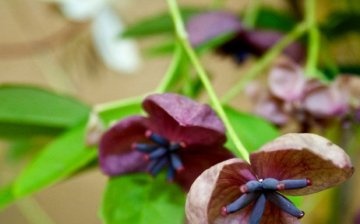
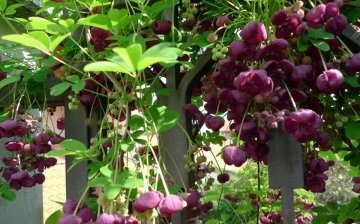
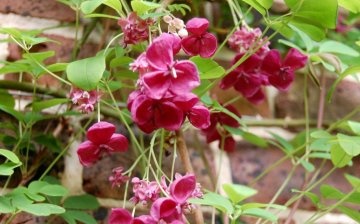
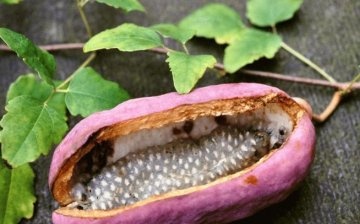
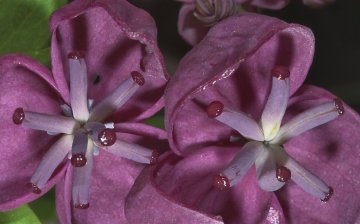
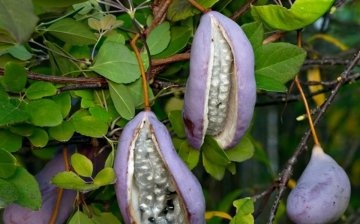
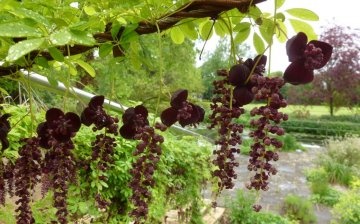









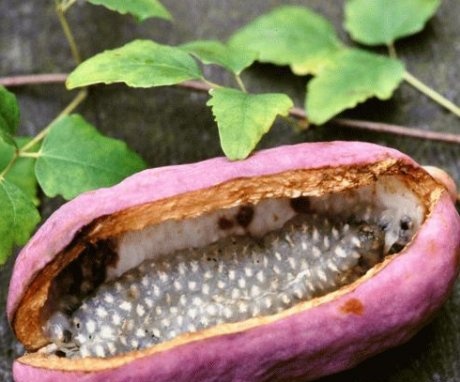

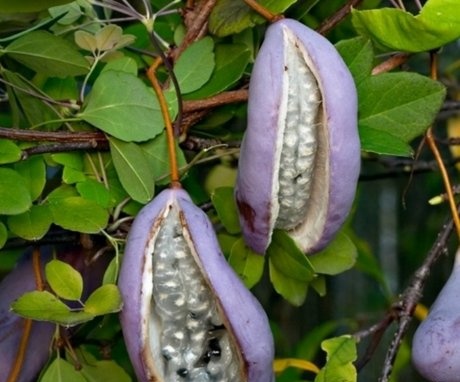
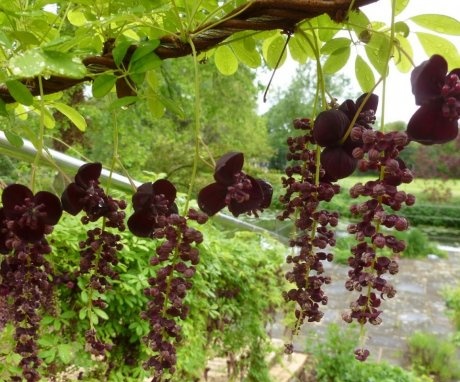
I met this flower, but not in our latitudes, but in the south, there are of course all the conditions for its growth. In our climate, I think he will not be comfortable. The winters are very cold and the summers are hot. Although I really love vines and would love to try to grow such a beauty in my own place.
A neighbor has such a liana, and he let it go along a long trellis, which is attached to asbestos pipes a meter or a half above the ground. It grows well, juicy, flowers of high quality and care for it is minimal.